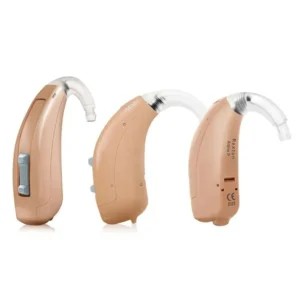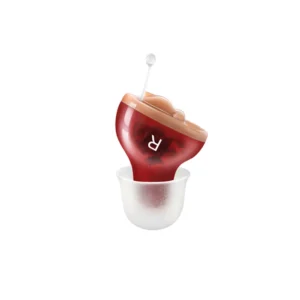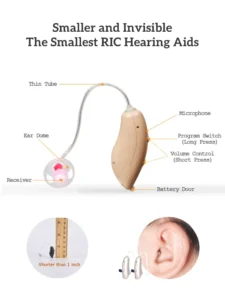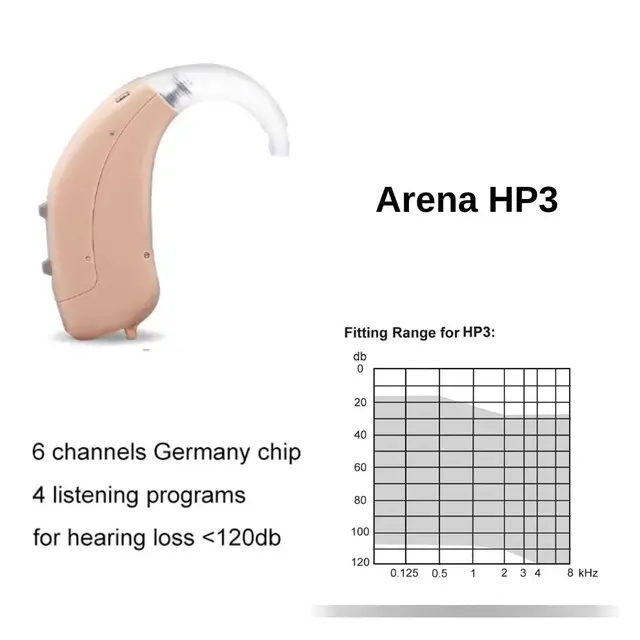Which are the Best Hearing Aids?
Talking about Best Hearing Aids; a hearing aid is a small electronic device designed to improve hearing for individuals with hearing loss. It consists of a microphone, amplifier, and speaker. The microphone picks up sound from the environment, which is then processed and amplified by the device. The amplified sound is delivered to the ear through a speaker, making it easier for the individual to hear and understand speech and other sounds.
Modern hearing aids come in various styles and sizes, ranging from tiny devices that fit completely in the ear canal to larger behind-the-ear models. They can be customized to suit individual hearing needs and preferences, and many feature advanced technologies such as noise reduction, directional microphones, and wireless connectivity to other devices like smartphones or TVs.

Styles and Sizes of Hearing Aid:
Hearing aids come in various styles and sizes to suit different preferences and levels of hearing loss. Here are some common styles:
1. **Behind-the-Ear (BTE)**:
– BTE hearing aids rest behind the ear and have a tube that connects to a custom earpiece or earmold fitted inside the ear canal.
– They are suitable for a wide range of hearing losses and are typically more powerful, making them suitable for severe to profound hearing loss.
2. **Receiver-in-Canal (RIC) or Receiver-in-the-Ear (RITE)**:
– Similar to BTE aids, RIC/RITE hearing aids also sit behind the ear, but the speaker (receiver) is placed inside the ear canal instead of in the main body of the device.
– They are smaller and less visible compared to traditional BTE aids.
3. **In-the-Ear (ITE)**:
– ITE hearing aids are custom-made to fit the shape of the wearer’s ear and fill the outer part of the ear.
– They are larger than canal-style aids but offer more space for features like directional microphones and volume controls.
4. **In-the-Canal (ITC)**:
– ITC hearing aids are custom-made to fit partially in the ear canal, making them less visible.
– They are larger than completely-in-the-canal (CIC) aids but provide more features and easier handling.
5. **Completely-in-the-Canal (CIC)**:
– CIC hearing aids are the smallest custom-made available, fitting completely inside the ear canal.
– They are almost invisible when worn and provide a more natural sound because they use the ear’s anatomy to collect sound.
6. **Invisible-in-Canal (IIC)**:
– IIC hearing aids are the most discreet type, fitting deep inside the ear canal where they are virtually invisible.
– They are custom-made and suitable for mild to moderate hearing loss.
The choice of style depends on factors such as the degree of hearing loss, ear shape and size, manual dexterity, and cosmetic preferences. It’s essential for individuals to consult with an audiologist or hearing care professional to determine the most suitable style and features for their needs.

Best Brand Hearing Aids :
Determining the “best” brand of hearing aids can be subjective and depends on individual needs, preferences, and budget. However, several brands are well-regarded in the industry for their innovation, quality, and customer satisfaction. Here are some of the top brands:
1. **Oticon**: Known for its cutting-edge technology and focus on personalized hearing solutions, Oticon offers a wide range of hearing aids catering to different types and degrees of hearing loss.
2. **Phonak**: Phonak is recognized for its innovative technology, including rechargeable devices, Bluetooth connectivity, and specialized features for challenging listening environments.
3. **Widex**: Widex is known for its advanced sound processing technology and emphasis on natural sound quality. Their hearing aids often feature personalized fitting options and wireless connectivity.
4. **Siemens/Signia**: Siemens, now operating as Signia, produces a diverse range with features like rechargeability, tinnitus management, and advanced noise reduction.
5. **ReSound**: ReSound is acclaimed for its Smart Hearing technology, offering features like direct streaming, remote fine-tuning, and compatibility with smartphones and other devices.
6. **Starkey**: Starkey Hearing Technologies is known for its Made for iPhone hearing aids, as well as its focus on providing personalized solutions and superior sound quality.
7. **Unitron**: Unitron is recognized for its innovative approach to hearing care, offering a variety with features such as automatic adaptation to different listening environments and personalized sound profiles.
8. **Bernafon**: Bernafon is known for its high-quality featuring cutting-edge technology, including Bluetooth connectivity and advanced noise reduction.
It’s essential to consult with an audiologist or hearing care professional to determine the most suitable brand and model based on your specific hearing needs, lifestyle, and preferences. They can provide guidance and recommendations tailored to your individual circumstances. Additionally, factors like warranty, customer service, and ongoing support should also be considered when selecting a brand.
The cost of hearing aids can vary widely depending on several factors, including the brand, model, features, and where you purchase them. Generally, prices for a single hearing aid can range from a few hundred dollars to several thousand dollars. Here’s a breakdown of approximate price ranges:
1. **Economy or Basic Models**: These typically range from $500 to $1,500 per hearing aid. They often offer essential features and may not have advanced technology or connectivity options.
2. **Mid-Range Models**: These usually cost between $1,500 and $3,000 per hearing aid. They may offer more advanced features such as noise reduction, directional microphones, and Bluetooth connectivity.
3. **Premium or Advanced Models**: Prices for premium hearing aids can range from $3,000 to $6,000 or more per one. These devices often include the latest technology, such as artificial intelligence, rechargeability, and enhanced customization options.
Factors that can influence the cost of hearing aids include:
– **Technology Level**: Advanced features and processing capabilities typically come with a higher price tag.
– **Style**: In-the-ear (ITE) and completely-in-the-canal (CIC) hearing aids tend to be more expensive than behind-the-ear (BTE) models due to their smaller size and custom fitting.
– **Brand**: Some brands may command higher prices due to their reputation, technology, and customer service.
– **Additional Accessories**: Costs can increase if you opt for accessories like remote controls, wireless streamers, or rechargeable batteries.
– **Professional Services**: The cost of hearing aids often includes fitting, adjustments, and follow-up appointments with an audiologist or hearing care professional.

– **Warranty and Maintenance**: Extended warranties or maintenance plans may add to the overall cost but can provide peace of mind and long-term savings.
It’s essential to consider not only the upfront cost but also the value and benefits that it offers in improving your quality of life and communication. Many hearing care providers offer financing options or payment plans to help make hearing aids more affordable. Additionally, some insurance plans may cover part or all of the cost, so it’s worth checking with your insurance provider.
How Long Do Hearing Aids Last?
Hearing aids typically last between 3 to 7 years, depending on factors like the quality of the device, how well it’s maintained, and the user’s lifestyle. Regular cleaning, proper storage, and routine maintenance can help extend their lifespan. If you notice any issues with performance or functionality, it might be time to consult an audiologist or consider a replacement.
How to get a Hearing Aid?
Getting a hearing aid involves several steps, from evaluating your hearing needs to selecting and fitting the right device. Here’s a general outline of the process:
- Schedule a Hearing Test: Start by seeing an audiologist or an ear, nose, and throat (ENT) specialist for a comprehensive hearing evaluation. This will help determine the degree of hearing loss and whether a hearing-aid is appropriate for you.
- Consult with a Hearing Specialist: Based on the results of your hearing test, your audiologist will discuss your options. They will help you understand the types of hearing-aids available, their features, and which might be best suited for your hearing loss and lifestyle.
- Choose the Hearing Aid: There are various types of hearing-aids, such as behind-the-ear (BTE), in-the-ear (ITE), and completely-in-canal (CIC), each with different features and styles. Your audiologist will help you choose one that fits your needs and preferences.
- Get a Custom Fit: If necessary, your audiologist will take impressions of your ears to ensure a custom fit for the hearing-aid. This is especially important for in-the-ear models.
- Programming and Fitting: Once the hearing-aid is ready, your audiologist will program it according to your specific hearing needs and adjust it for optimal comfort and performance. They will also teach you how to use and care for your hearing-aid.
- Follow-Up Appointments: After you start using your hearing-aids, follow-up visits are essential to fine-tune the settings and address any issues or adjustments needed.
- Consider Financial Aspects: Check with your insurance provider to see if hearing-aids are covered. Some health insurance plans and government programs offer partial or full coverage for hearing-aids. Additionally, some audiologists offer payment plans or financing options.
By following these steps, you can ensure that you get a hearing-aid that meets your needs and enhances your hearing experience.
Are Cheap Hearing Aids Worth Buying?
Cheap hearing aids can be tempting due to their lower price, but whether they are worth buying depends on several factors. Here are some considerations to keep in mind:
- Performance and Quality: Inexpensive hearing-aids may not offer the same level of sound quality, amplification, or advanced features as more expensive models. They might struggle with background noise, feedback, or clarity, which can impact your overall listening experience.
- Fit and Comfort: Lower-cost hearing-aids may not be custom-fitted to your ear, which can affect comfort and effectiveness. Poor fit can also lead to issues like ear infections or discomfort.
- Durability and Reliability: Cheaper models might use lower-quality materials and components, which can affect their longevity and reliability. You might end up needing frequent repairs or replacements.
- Technology and Features: Expensive hearing-aids often come with advanced features such as Bluetooth connectivity, directional microphones, and automatic adjustments. Cheap hearing-aids may lack these features, which can limit their functionality and adaptability.
- Support and Service: Higher-end hearing aids typically come with better customer support, including professional fitting and follow-up care. Cheap hearing-aids may not offer the same level of service or support, which can be crucial for adjusting the device to your specific needs.
- Suitability for Your Hearing Loss: Over-the-counter (OTC) hearing-aids and budget models might be suitable for mild to moderate hearing loss but may not be effective for more severe hearing impairments.
- Regulatory and Safety Concerns: Ensure that any hearing-aid you consider meets regulatory standards for safety and efficacy. Some cheap models might not be subject to rigorous quality controls.
Sometimes, investing a bit more in a hearing-aid with better quality and support can provide significant long-term benefits.
Can Airpods be used as Hearing Aids?
AirPods and other similar wireless earbuds are not designed to function as hearing aids, but they do have some features that might offer limited assistance for people with mild hearing loss. Here’s a breakdown of their capabilities and limitations:
Capabilities:
- Hearing Enhancement: AirPods Pro and AirPods Max have a feature called “Live Listen,” which can amplify sounds and help users hear conversations better. This feature can be useful in certain situations but is not a substitute for a hearing-aid.
- Sound Quality: AirPods provide high-quality audio for listening to music and calls, which might help with hearing in specific contexts, like listening to podcasts or phone conversations.
- Noise Cancellation: AirPods Pro and Max come with active noise cancellation, which can help reduce background noise, making it easier to focus on conversations or specific sounds.
Limitations:
- Not Designed for Hearing Loss: Unlike hearing-aids, AirPods are not tailored to address specific hearing impairments. Hearing-aids are custom-fitted and programmed to enhance specific frequencies based on your hearing test results.
- Lack of Professional Support: Hearing-aids come with professional fitting, tuning, and ongoing support from audiologists. AirPods do not offer this kind of personalized service or adjustments.
- Limited Amplification: While AirPods can amplify sound to some extent, they lack the advanced amplification and noise management features of hearing-aids, which are crucial for managing hearing loss in various environments.
- Regulatory Approval: Hearing-aids are medical devices regulated by authorities like the FDA in the U.S., ensuring they meet specific standards for safety and efficacy. AirPods are consumer electronics and do not have this level of regulatory oversight for hearing assistance.
Considerations:
While AirPods may offer some temporary assistance, they are not a replacement for professionally prescribed hearing-aids.
Can Hearing Aids cause Ear Infections?
Hearing aids themselves do not directly cause ear infections, but improper use, maintenance, or fit can increase the risk of developing an ear infection. Here are some ways this might happen and how to mitigate the risks:
Ways Hearing Aids Might Contribute to Ear Infections:
- Poor Hygiene: If hearing aids are not cleaned regularly, they can accumulate dirt, wax, and bacteria, which might increase the risk of ear infections.
- Improper Fit: Hearing aids that do not fit properly can cause irritation or sores in the ear canal. These sores can become infected if not addressed.
- Moisture Accumulation: Moisture trapped in the ear canal due to improper use or moisture in the hearing-aid can create an environment conducive to bacterial growth.
- Excessive Earwax: Hearing aids can push earwax further into the ear canal, potentially leading to a buildup that can cause discomfort and infection.
- Allergic Reactions: Some people may be allergic to the materials used in hearing-aids, which can cause inflammation or irritation in the ear canal.
Preventive Measures:
- Regular Cleaning: Clean your hearing-aids as recommended by the manufacturer and your audiologist. This includes wiping down the devices and cleaning any ear molds or tips.
- Proper Fit: Ensure your hearing aids are properly fitted. If you experience discomfort, consult your audiologist to adjust the fit or address any issues.
- Dry Ears: Keep your ears dry and avoid wearing hearing-aids if your ears are wet from swimming or showering. Use dehumidifiers or drying kits designed for hearing aids if needed.
- Routine Ear Checks: Have your ears checked regularly by a healthcare professional to ensure there are no issues with earwax buildup or other conditions that could increase infection risk.
- Avoid Sharing: Do not share your hearing-aids with others to prevent cross-contamination and potential infections.
- Professional Advice: If you notice any signs of an ear infection, such as pain, discharge, or itching, consult your healthcare provider promptly. They can diagnose and treat any infections and provide guidance on how to use your hearing-aids safely.
By following these preventive measures you can minimize the risk of ear infections while using hearing-aids.
Can Hearing Aids make Tinnitus Worse?
Hearing aids are generally designed to help with hearing loss and can often improve the quality of life for those with tinnitus. However, there are some cases where hearing aids might seem to exacerbate tinnitus or cause discomfort. Here’s how hearing-aids might impact tinnitus and what you can do about it:
Possible Reasons Hearing Aids Might Affect Tinnitus:
- Volume Levels: If the hearing aid is set too high, it might amplify background noises or internal sounds, potentially worsening tinnitus or making it more noticeable.
- Adjustment Period: When you first start using hearing-aids, it can take some time for your brain to adjust to the new sound environment. During this period, tinnitus might seem more pronounced as you become more aware of all the sounds around you.
- Fit and Comfort: Poorly fitting hearing-aids can cause discomfort or pressure in the ear, which might make tinnitus more noticeable or irritating.
- Feedback and Whistling: Some hearing-aids may produce feedback or whistling sounds if they are not properly fitted or adjusted, which can be distracting and exacerbate tinnitus symptoms.
- Changes in Sound Perception: Hearing-aids can change how you perceive sounds, and for some individuals, this might temporarily affect their tinnitus perception.
Steps to Manage Tinnitus with Hearing-Aids:
- Consult Your Audiologist: If you experience increased tinnitus or discomfort, talk to your audiologist. They can adjust the settings of your hearing-aids or check the fit to ensure they are not contributing to the problem.
- Fine-Tuning: Your audiologist can fine-tune the amplification and frequency settings to balance sound quality and minimize tinnitus.
- Consider Tinnitus Features: Some modern hearing-aids come with built-in tinnitus masking or relief features, such as white noise or sound therapy options. Discuss these features with your audiologist to see if they might help.
- Gradual Adjustment: If you’re new to hearing-aids, give yourself time to adjust to the new sounds. It may take a few weeks for your brain to adapt, during which tinnitus might fluctuate.
- Proper Fit: Ensure that your hearing-aids are properly fitted and comfortable. If they are causing physical discomfort, this can exacerbate tinnitus symptoms.
- Manage Expectations: Understand that while hearing-aids can improve hearing and reduce the impact of tinnitus, they might not completely eliminate tinnitus. They are a tool to help manage the condition, not a cure.
When to Seek Additional Help:
- If tinnitus persists or worsens despite adjusting your hearing aids, or if it becomes more bothersome, consult your healthcare provider. They might recommend additional treatments or therapies for managing tinnitus.
- Sometimes, underlying health issues might contribute to tinnitus, and a comprehensive evaluation by a specialist can help address these issues.
In summary, while hearing aids are not likely to worsen tinnitus directly, improper use or adjustment might make symptoms more noticeable.
Where to Donate Hearing-Aids?
Donating hearing aids is a great way to help those in need. Several organizations accept donated hearing aids, refurbish them, and provide them to individuals who may not otherwise afford them. Here are some places where you can donate hearing-aids:
Organizations and Programs:
- Starkey Hearing Foundation:
- Website: Starkey Hearing Foundation
- Details: Starkey Hearing Foundation accepts donated hearing-aids and refurbishes them for distribution to individuals in need around the world.
- Hearing Life Foundation:
- Website: Hearing Life Foundation
- Details: The Hearing Life Foundation collects used hearing-aids, which are then refurbished and given to individuals who need them.
- Lions Clubs International:
- Website: Lions Clubs International
- Details: Many local Lions Clubs accept hearing-aid donations. They refurbish the aids and distribute them to people in need through their hearing-aid recycling program.
- American Hearing Research Foundation (AHRF):
- Website: AHRF
- Details: AHRF may accept hearing-aid donations and is involved in funding research and support for hearing-related causes.
- ReSound Hearing Aid Donation Program:
- Operation Hearing Foundation:
- Website: Operation Hearing Foundation
- Details: This organization collects and refurbishes hearing-aids for distribution to those in need.
- Hearing Aid Project:
- Website: Hearing-Aid Project
- Details: The Hearing-Aid Project refurbishes donated hearing-aids and provides them to low-income individuals and families.
Local Options:
- Local Audiologists and Hearing-Aid Clinics: Some audiologists and hearing aid clinics accept donations and may work with charities or programs that refurbish and distribute used hearing-aids.
- Hospitals and Nonprofits: Check with local hospitals, health centers, or nonprofits that focus on health and community services. They might have information about hearing-aid donation programs.
- Senior Centers and Community Organizations: Contact local senior centers or community organizations; they might have programs or partnerships for hearing-aid donations.
How to Donate:
- Clean the Hearing-Aids: Before donating, clean the hearing-aids according to the manufacturer’s instructions.
- Package Properly: Place the hearing-aids in a clean, secure package or box.
- Include Accessories: If possible, include any accessories, such as ear molds or batteries.
- Contact the Organization: Reach out to the organization to confirm their donation process and any specific requirements.
By donating your hearing-aids, you can make a significant difference in someone’s life and help improve their hearing health.
Facebook
Twitter
Instagram
Check out hearing aid price







